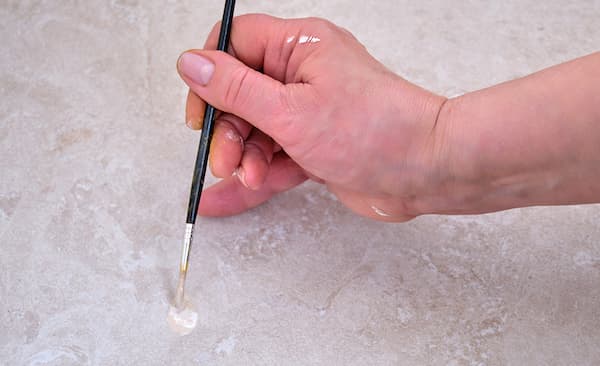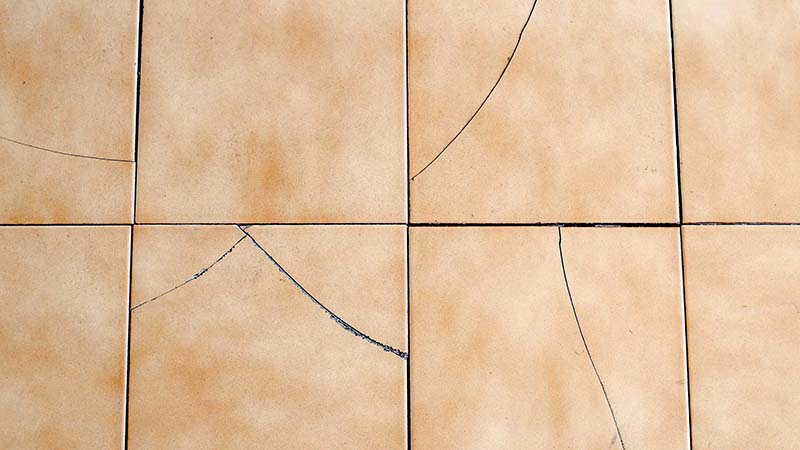If homeowners don’t know how to fix cracked tiles, they might encounter hairline fractures on their tile floors. Here is how to repair a broken floor tile without replacing it.
- Remove Any Debris and Clean the Cracked Tile
- Mix a Two-part Epoxy, Following the Manufacturer’s Instructions
- Apply the Epoxy to the Crack and Wait for It to Cure
- Use Paint to Match the Existing Tile Color and Seal the Color Once It’s Dry
- Consider Hiring a Professional to Repair Large Cracks Or Replace Tiles
Please continue reading for more information.
Things You Should Know
- The crack should be filled with a 2-part epoxy mixture. To make the repair blend in with your tile, paint it after the epoxy has dried.
- Use nail polish that matches the shade of your tile to cover the crack repeatedly until it is no longer noticeable for a simple and quick fix.
- For a professional fix, break the tile with a center punch and hammer, then replace it with mortar and grout.
How to Fix Cracked Tiles?
Remove Any Debris and Clean the Cracked Tile
Ensure that the tile floor is free of debris, grease, and dirt before starting to repair cracked tile without removing it. It is preferable to have the cleanest surface possible to ensure the best results and a flawless finished product, even though a small amount of dust won’t affect epoxy’s effectiveness.
To clean the floor, use a paper towel and rubbing alcohol or dish soap and water. In order for the epoxy to adhere, make sure the floor is completely dry before continuing. To remove extra moisture, wipe the surface with a microfiber cloth or paper towel.
Mix a Two-part Epoxy, Following the Manufacturer’s Instructions
The two tile pieces are held together by an adhesive paste made from two parts epoxy, which combines hardener and resin to form a bond. Two-part epoxy can be bought online or at a nearby hardware store. Depending on the brand, two-part clear epoxy kits can range in price, but many are under $10.
It is typically advised to mix the epoxy on a piece of cardboard and work from there. For the chemicals to interact and create a suitable adhesive mixture, make sure the solution from each bottle is thoroughly mixed. During this phase, open windows and remember to wear gloves and a face mask.
Prior to curing, epoxy will remain usable for a sizable amount of time; however, if left unattended for a protracted period of time, it will become rigid. It is therefore best to move swiftly during this process.
Apply the Epoxy to the Crack and Wait for It to Cure

Depending on the size of the crack, use a popsicle stick or toothpick to apply some epoxy to it after it has been thoroughly mixed. A popsicle stick will make it simpler to transfer a larger amount of product to a wider crack while a toothpick will be more precise for smaller gaps. By applying a thin, even coat of epoxy, cover the crack. Apply epoxy at least half a centimeter on either side of the crack, being careful to keep epoxy away from the grout.
In about 10 to 15 minutes, the epoxy should be completely dry. After 15 minutes, check to see if the epoxy is dry and firm to the touch by tapping it with a gloved hand.
Use Paint to Match the Existing Tile Color and Seal the Color Once It’s Dry
Once the epoxy has dried, cover it with an oil- or urethane-based paint that matches the color of the surrounding tiles using a detail paintbrush. Another option is to use epoxy-specific powder dye, which can be purchased at hobby or craft stores. It might be more difficult to match this substance to the tile, and you might need to touch it up with paint.
Once the finished product has dried, seal it with urethane sealer to give it extra protection.
Consider Hiring a Professional to Repair Large Cracks Or Replace Tiles
The aforementioned technique is ideal for mending cracked tile. The only option, though, might be to replace the tile if it has been broken or has a sizable crack. An expert can help homeowners with the replacement process and might even be able to fix significant cracks without needing to buy new tile. To figure out what to do, speak with a handyman or tile repair professional.
Epoxy has been successfully used to repair cracked floor tiles in numerous situations. If homeowners are unsure whether the size of their tile crack is too large for epoxy repair, they should speak with a professional to help allay any worries and jumpstart the tile repair or replacement process. When mixing and using epoxy, keep in mind to put on gloves and a face shield. While the epoxy is drying, keep all family members, especially kids and pets, away from the area.
Read about What Type Of Flooring Can You Put Over Ceramic Tile?
How to Repair Cracked Grout Around Tile?
The good news is that cracked grout can be easily fixed with a few basic tools.
Here’s what you need to do:
- Utilize an oscillating saw or a small grout saw to cut away any cracked grout surrounding the tile.
- To get rid of any buildup or dirt, scrub the surrounding grout with a household cleaner. This makes it much simpler to match the colors of the grout.
- To get rid of all the grout you removed and any dust that was left behind, thoroughly vacuum the area using the hose attachment.
- A small amount of grout should be prepared as directed on the package, using a color that matches the existing grout.
- Using a grout float, fill in the spaces between the tiles with the grout mixture. Scrape off any excess after pressing into the voids to ensure a nice fill.
- After letting it air dry for about 30 minutes, use a damp sponge to remove the leftovers.
- Depending on the type of grout you bought, give it about 24 hours to dry before sealing with a grout sealant.
What Causes Hairline Cracks in Tile?
Your tile may have cracked as a result of something as simple as being dropped on it or as complicated as the floor being installed improperly.
Under normal use, tiles can crack if the flooring is uneven or if there is debris or dried grout underneath.
Suggested reading: What color grout to use with gray tile? Overall, some colored grout contrasts with gray tiles: light gray, off white, taupe, brown, charcoal gray, cream, dark gray, and gray porcelain.
Can Porcelain Tile Be Repaired?
Short answer, yes!
If porcelain tiles become chipped, they can typically be fixed quickly.
You can get a tile repair kit like this one, which includes putty and multiple pigments for you to fill the chip and match the color.
These kits are fairly easy to use and inexpensive.
If your tile is cracked, replacing the entire tile may be necessary rather than just fixing the damage. If not treated properly, cracked tiles can trap moisture and result in water damage.
Read about Can You Tile Over Tile?
So, How to Fix Cracked Tiles?
Here’s the steps on how to fix cracked tiles
- Remove Any Debris and Clean the Cracked Tile
- Mix a Two-part Epoxy, Following the Manufacturer’s Instructions
- Apply the Epoxy to the Crack and Wait for It to Cure
- Use Paint to Match the Existing Tile Color and Seal the Color Once It’s Dry
- Consider Hiring a Professional to Repair Large Cracks Or Replace Tiles
You’re not stuck with the crack indefinitely if one of your floor or countertop tiles has cracked due to normal wear and tear or an unfortunate accident. It’s surprisingly simple to fix a cracked tile, and if you’d prefer to replace it entirely, you can do that as well.
Thank you for reading.



